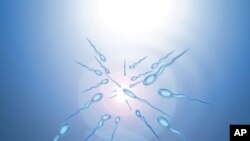Scientists for the first time have produced fertile sperm cells in a test tube. The technique offers hope to infertile men as well as to young male cancer patients worried about being able to father children later in life.
Cancer chemotherapy can be a life-saving procedure, but it can also damage reproductive cells and leave some patients sterile. Faced with that prospect, adult male cancer patients can choose to collect and freeze their sperm prior to undergoing treatment so they will be able to father offspring at a later time.
But Marco Seandel, a medical oncologist at Weill Cornell Medical College in New York, says pre-pubescent boys undergoing cancer treatment do not yet have that option.
"They have the building blocks to form sperm, but no sperm to freeze down the way you would do in an adult who would be requiring chemotherapy that could potentially be destroying those very same cells," explained Seandel.
Successful research
Now Japanese researchers have found a way to culture sperm cells and grow them to maturity outside the body. They took tissue from the testicles of newborn mice, grew the cells into fertile sperm in a test tube filled with a protein-rich soup, injected them into mouse eggs and produced 12 healthy, and fertile, mouse offspring.
The investigators were able to achieve the same results using sperm grown from testes cells that had been frozen with liquid nitrogen for several weeks.
The research is significant, according to Seandal, because potent sperm cells have never before been created in the laboratory. The biology of sperm creation is very complex, Seandel says. It normally takes more than a month in mice and close to three months in humans for sperm cells to develop and mature, and the process is fraught with potential pitfalls.
"And requires many, many orchestrated signals and changes in the shape and programming of the cells along the way," he noted.
Cautionary note
Marco Seandel cautions the creation of fertile sperm cells in mice is the first of many steps on the way to being able to create human sperm cells.
"I think the big question is whether the cells are normal or shall we say normal enough one would consider testing them in humans. And we do not know how these cells would perform on a scale of many generations," added Seandel.
The article describing the first test-tube sperm creation, and a commentary by Marco Seandel of Weill Cornell Medical College, is published this week in the journal Nature.








